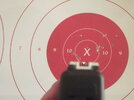They are describing the "how" but not the "why".
- Are these instructions ambiguous? How can both techniques yield proper aim?
The first sight picture, which they refer to as Point of Aim is a good all purpose sighting technique especially at varying/unknown distances
The second sight picture, 6 o'clock hold is good for accurately shooting at known distances where you can allow for how high above your Point of Aim (POA) the bullseye is.
Covering the target is something that arrived with the increased use of 3-dot sights and only gives a very coarse aiming point
That is a way that is somewhat popular, because it takes less effort to align your sights on a target that you can't actually see be because you're covering your target with the front sight
- So there is no recommendation to place the front sight directly over the intended target? (By "over," I mean blocking it or superimposing the center dot on the bull's eye.) That's how I've been doing it, and apparently I've been doing it wrong.
You're seeing the dotted line as the target...it isn't. The target is the solid line forming the outer circle.
- It seems that in the second picture, the bull's eye is not centered in the target. Am I interpreting this wrong?
What's throwing you off is that the target is smaller in the 2nd picture so that you can better visualize the relationship between the aligned sights and the target
While they are popular, any dots or outlines on the rear blade will actually distract from rapid alignment of your sights...because you're trying to align them with the front dot. Many folks find that a fiber optic dot, or even a plain dot on the front sight helps them find it faster...but you have to keep in mind that it isn't meant as an aiming point so much as an aid to sight locationI'm finding I like brighter, more visible sights, such as white dots front and rear, but I'm wondering whether a fiber optic front sight might be better.



